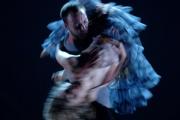Ferocious Beauty: Genome
Liz Lerman Dance Exchange’s 2006 Ferocious Beauty: Genome project, a touring performance created in collaboration with geneticists and educators, explored how knowledge of the genome “will change the way we think about aging, perfection, ancestry and evolution.” The performance integrates elements of dance and theater with state-of-the-art recorded and live-feed video and multichannel soundscape, including dialogue with scientists. In the time-tested style of choreographer Liz Lerman, the subject is represented through a plurality of viewpoints, mirroring a dialogue among multiple voices─artistic, scientific and scholarly─from their varied perspectives. The creation process and public presentations incorporated community-centered activities including: an art exhibit of works exploring the impact of genetic research; a panel discussion titled “Lived Experience and the Human Genome Debate;” a symposium about race; a master class partnering scientists and artists; a town hall meeting on stem-cell research; a lecture on reproductive technologies and more. Lerman calls this artwork an example of “nonfiction dancing” or “subject-matter choreography,” that is, art exploring real-world issues, created through deep collaboration with communities. In this case, Dance Exchange was involved for four years in the scientific and educational communities. “We have designed the piece,” she writes, “to let the scientists speak for themselves, though subject to our editing. We chose the ideas to highlight through long conversations among ourselves, with the scientists, and with the public.” Ferocious Beauty is also an example of a strong arts partnership between a company and a campus presenter. Dance Exchange has a long history of integrating itself into a particular university setting and working with the on- and off-campus communities to create and perform new work from those particular perspectives. This piece premiered in 2006 at Wesleyan University in Connecticut. Wesleyan’s Center for the Arts initiated a number of community-centered activities in concert with the premiere. These included an art exhibit of works exploring the impact of genetic research and a panel discussion titled “Lived Experience and the Human Genome Debate.” The creation and touring process also included other community-centered activities: a symposium about race; a master class partnering scientists and artists; a town hall meeting on stem-cell research; and a lecture on reproductive technologies and more. Audiences were exposed to the subject matter from many angles, deepening their understanding of the ways this scientific discovery of biological information about living organisms is changing their lives. And they experienced a refreshing change when they were offered opportunities to investigate the benefits of genetic science freely, unburdened by the divisive political conflict around stem-cell research. These community-centered events “brought people whose conditions may be helped by genetic research together with artists, ethicists, scientists, and religious thinkers,” reports the company. “It represented a departure from many discussions that focus on stem-cell research by including the voices of people and families for [whom] genetic research holds hope and promise.” The communities involved in this intensive experience went beyond audiences and the participants in community-centered activities. It deeply engaged groups of people in the artistic, scientific and educational communities as well, presenting them with some surprising challenges. The Dance Exchange’s own understanding of artistic expression was enhanced by working intensively over time within another sector of knowledge: science. Collaborators included representatives of such institutions as NIH, John Hopkins University, Stanford University, Howard University, the Genetics and Public Policy Center, the Institute for Genomic Research, and the U.S. Department of Energy. “Along the way,” wrote Lerman, “we learned how structure, characters, and meaning can come to artists when they rattle around in someone else’s universe.” Scientists were challenged in their experience of the arts: Bonnie Bassler, professor of Molecular Biology at Princeton University and an adviser to the project, said: When Lerman told me she was working on a piece about biology, I was doubly curious because I wondered how one communicates biology through dance. That being said, I know that science is scary to a lot of people because they feel they don't have the background. … Combining science with art [can] allow the public a gentler way into understanding science. The ideas and processes of the work were also available to people in the scientific community who didn’t see it. The piece was reviewed in depth by publications as diverse as the New York Times, Howard Hughes Medical Bulletin, and DNA Policy News. On the campus at Wesleyan, students, faculty, and staff learned much about the potential of arts integration: "In terms of the university,” said Pamela Tatge, director of Wesleyan’s Center for the Arts, “we are profoundly changed by this experience. The bar is set now for having artists integrated into many aspects of campus life. It's been a terrific catalyst for interdisciplinary collaboration."
